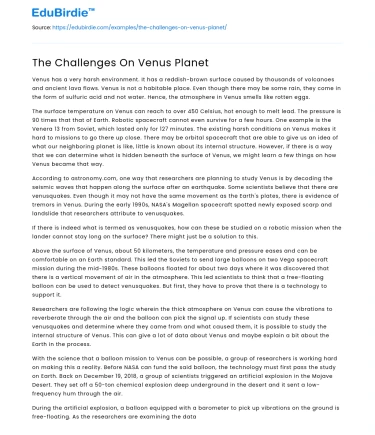Venus has a very harsh environment. It has a reddish-brown surface caused by thousands of volcanoes and ancient lava flows. Venus is not a habitable place. Even though there may be some rain, they come in the form of sulfuric acid and not water. Hence, the atmosphere in Venus smells like rotten eggs.
The surface temperature on Venus can reach to over 450 Celsius, hot enough to melt lead. The pressure is 90 times that that of Earth. Robotic spacecraft cannot even survive for a few hours. One example is the Venera 13 from Soviet, which lasted only for 127 minutes. The existing harsh conditions on Venus makes it hard to missions to go there up close. There may be orbital spacecraft that are able to give us an idea of what our neighboring planet is like, little is known about its internal structure. However, if there is a way that we can determine what is hidden beneath the surface of Venus, we might learn a few things on how Venus became that way.
Save your time!
We can take care of your essay
- Proper editing and formatting
- Free revision, title page, and bibliography
- Flexible prices and money-back guarantee
According to astronomy.com, one way that researchers are planning to study Venus is by decoding the seismic waves that happen along the surface after an earthquake. Some scientists believe that there are venusquakes. Even though it may not have the same movement as the Earth's plates, there is evidence of tremors in Venus. During the early 1990s, NASA's Magellan spacecraft spotted newly exposed scarp and landslide that researchers attribute to venusquakes.
If there is indeed what is termed as venusquakes, how can these be studied on a robotic mission when the lander cannot stay long on the surface? There might just be a solution to this.
Above the surface of Venus, about 50 kilometers, the temperature and pressure eases and can be comfortable on an Earth standard. This led the Soviets to send large balloons on two Vega spacecraft mission during the mid-1980s. These balloons floated for about two days where it was discovered that there is a vertical movement of air in the atmosphere. This led scientists to think that a free-floating balloon can be used to detect venusquakes. But first, they have to prove that there is a technology to support it.
Researchers are following the logic wherein the thick atmosphere on Venus can cause the vibrations to reverberate through the air and the balloon can pick the signal up. If scientists can study these venusquakes and determine where they came from and what caused them, it is possible to study the internal structure of Venus. This can give a lot of data about Venus and maybe explain a bit about the Earth in the process.
With the science that a balloon mission to Venus can be possible, a group of researchers is working hard on making this a reality. Before NASA can fund the said balloon, the technology must first pass the study on Earth. Back on December 19, 2018, a group of scientists triggered an artificial explosion in the Mojave Desert. They set off a 50-ton chemical explosion deep underground in the desert and it sent a low-frequency hum through the air.
During the artificial explosion, a balloon equipped with a barometer to pick up vibrations on the ground is free-floating. As the researchers are examining the data, they are expecting results that line up with previous studies where earthquakes are seen to generate airborne pressure waves. This will also cement the belief that a massive hammer ponded on the surface of the Earth can be picked up by floating balloons. Next step is to prove that balloons can pick up on natural tremors.
The next challenge is being able to prove that balloons can detect natural earthquakes and venusquakes. However, natural tremors do not happen at a scheduled time and place. Siddharth Krishnamoorthy, a researcher at NASA's Jet Propulsion Laboratory (JPL) who is involved in the balloon project said that they have been working with artificial quakes. Since humans are responsible for these seismic activities, researchers know where to go and when to go. The success of the balloon mission will depend on how fast the balloon can detect a real quake.
Researchers must be able to determine the difference among airborne signatures on Venus. For example, Earth has a different signature for volcanic eruptions, meteors, and lightning bolts.
Wind on Venus can complicate things for the balloon because wind speeds there depend on the altitude and do not flow steadily. The winds can reach 320 kilometers per hour, which can be detected as noise instead of signal. However, the winds can be used to the balloon's advantage because it can get a free ride to study other parts of the planet.
The researchers are planning on improving noise reduction techniques to address the balloon mission to Venus.






 Stuck on your essay?
Stuck on your essay?

